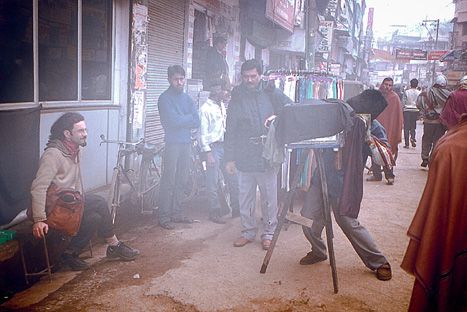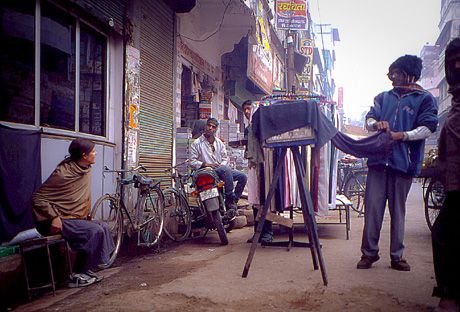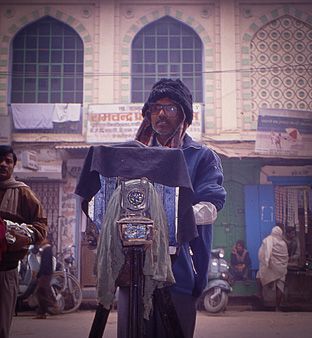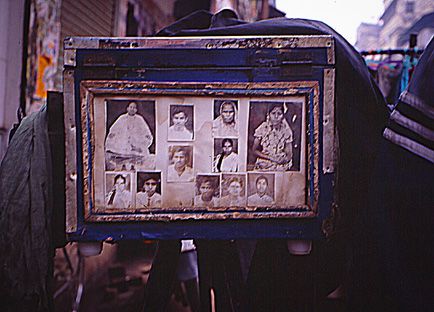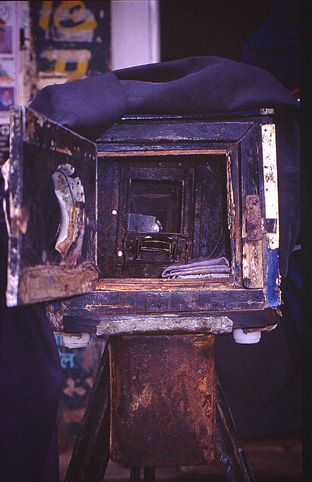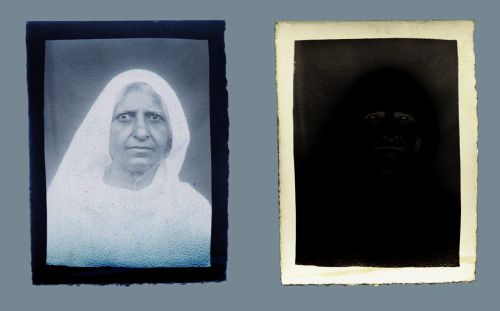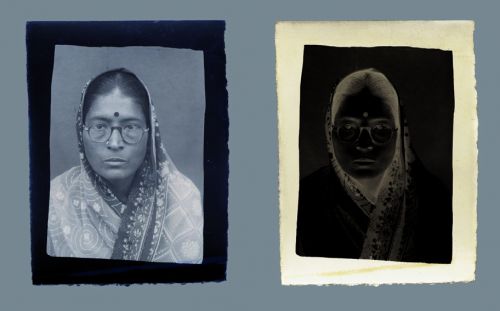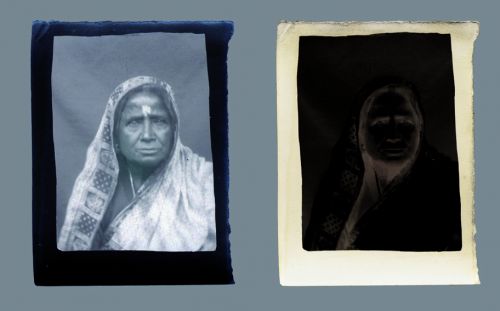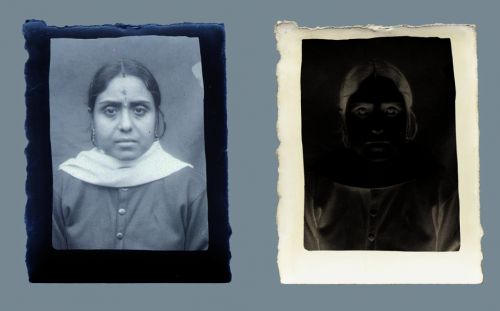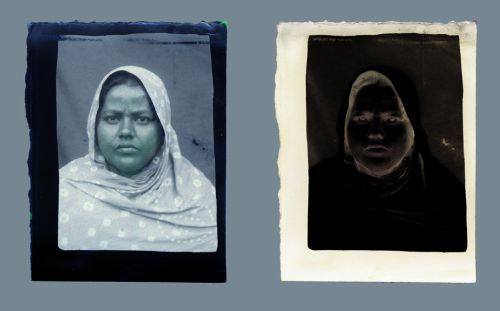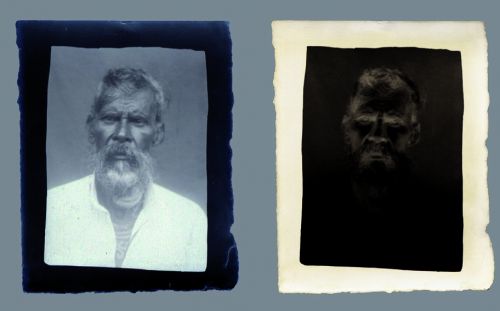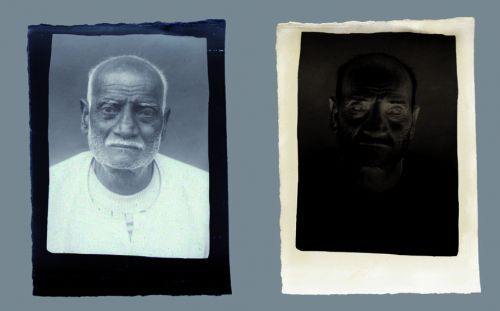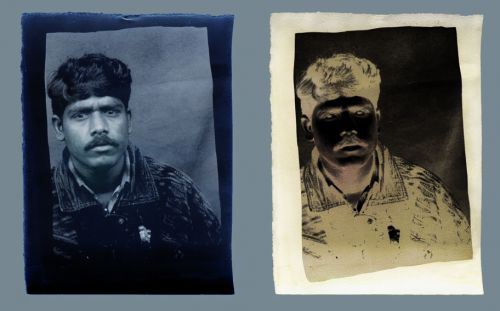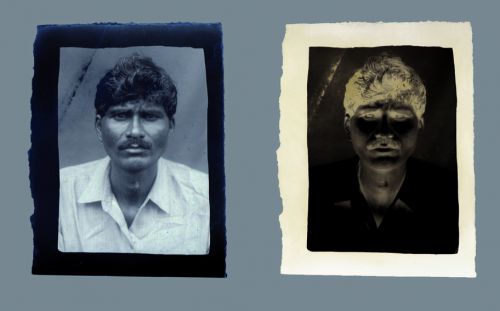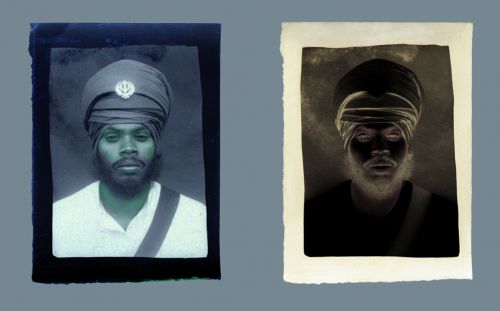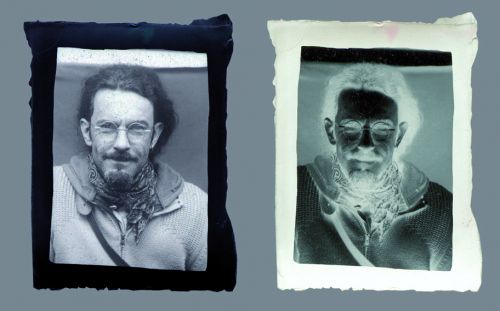Photographe de rue à Bénares /// Street photographer in Varanasi
Photographe de rue à Bénares
C'est en 1997 lors de mon premier voyage en Inde alors que je passais par Bénarès (autant commencer par du lourd) que je le remarquais sur le bord de la route. Il avait posé sa chambre au milieu d'une circulation congestionnée, et pour quelques roupies il vous immortalisait "à sa façon". On était en novembre et l'air frais des Himalayas avaient déjà recouvert la vallée dégagée du Gange. Notre homme était bien couvert, les oreilles et le sens du devoir bien à l'abri sous un bonnet de poils synthétiques, l'oeil tout dehors, prêt pour sa journée dans les gazs d'échappement. Il était photographe de rue, avait hérité d'une machine datant de l'ère glaciaire, professionnellement aussi autonome qu'une bernique sur son rocher, qu'une moule sur son poteau, et son matériel aussi pérenne qu'un menhir d'Obélix (j'ai la métaphore toujours un peu bretonne, on ne se refait pas tous les jours).
L'homme me paraissait exotique dans ce décor plutôt ubuesque et chaotique de Bénarès-les-flots où il est de bon ton de venir y déposer son dernier souffle, de l'eau du Gange jusqu'aux trous de nez.
Son studio avait le ciel pour plafond et l'infini impalpable pour murs, sauf que l'infini impalpable est vite obstrué dans une rue encombrée de Varanasi. Bon je précise à ce stade du récit que Bénarès, Varanasi et Kashi, c'est tout pareil. Cette ville méritait bien trois appellations pour renforcer la confusion.
A côté de lui et au milieu des autres aussi, son appareil photo-labo semblait avoir connu le mammouth et Néandertal. Posé sur un trépied en bois inoxydable, cette chambre-labo, voici encore 20 ans, avait pour mission de recueillir le reflet de tout ce qui à Bénarès voulait s'immortaliser sur papier et n'avait pas les moyens de finir chez Harcourt.
Cette machine captiva mon attention d'entrée de jeu, nostalgique que je suis des films de cow-boys et des livres de Edward Sheriff Curtis qui avait parcouru les Amériques au 19ème siècle, pressé par l'urgence de sauver ce qui restait à l'être des cultures indigènes amérindiennes pour récolter sur plaque de verre les reliquats aux abois d'un passé ancestrale ayant encore survécu aux invasions barbares venus principalement d’Europe. J'imagine qu’il photographia avec un avatar de cette machine antédiluvienne qui était planté là sous mes yeux incrédules et fascinés. Le principe premier de cette machine était simple : l'autonomie.
Avant de commencer sa prise de vue le photographe plaçait sur une des parois internes de l'appareil un petit morceau de papier qui allait recueillir l'image de ses clients. Puis lorsque le sujet était bien confortablement assis sur le rebord soutenant la vitrine d'une petite boutique, le photographe, bien dans l'axe, retirait pendant une paire de secondes le capuchon qui obstruait l'objectif.
Cette étape franchit, notre homme passait la main dans un manchon de tissu placé à l'arrière de son boitier et rentrait la main dans la chambre noire pour y décoller le morceau de papier sur la paroi interne puis la révéler en direct-live. Deux bains logeaient dans son boitier : un révélateur et un fixateur. Après avoir immergé son morceau de papier dans ces deux bains il ressortait la main du noir avec un négatif papier du portrait. L'ancêtre du polaroïd, l'encombrement en plus.
Restait à notre homme de réitérer la première étape qui consiste de placer à nouveau un papier vierge dans le boitier puis de placer à quelques centimètres de l'objectif sur un petit morceau de bois l'image, négatif humide du portrait du sujet, puis de retirer le capuchon de l'objectif pour quelques secondes. Par un ingénieux système à l'intérieur de la chambre, le photographe, après avoir passé derechef les étapes de développement, livrait au client son portrait en positif, soit en quatre photos passeport-size, soit en une seule grande photo. Et la magie fut !
Généralement le photographe donnait les positifs et jetais au sol sur place les négatifs. J'eus l'idée d'en ramasser une trentaine et je vous offre d'en découvrir une dizaine ci-dessous, négatifs qui grâce à photoshop se transformèrent instantanément en positifs, positifs qui se révélèrent à ma rétine après avoir voyagé trois mois en Inde, bien emballés et bien au chaud dans mon passeport posé sur mon coeur léger.
Street photographer in Varanasi 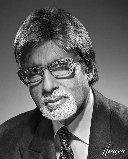
It’s in 1997 during my first trip in India, while I was having a stop in Varanasi (good to start with heavy stuff) that I noticed him on the roadside of a main street of the city, in the midth of a congested road traffic, and for a few rupees he would immortalized you « his way ». We were in November and the fresh air from the Himalayas just spreaded all over the Ganga valley. Our man was well covered, the ears and his sens of duty well protected under a synthetic hair beany, sharpened eyes all outside, ready for his days within the traffic smoke. He was street photographer who inherited of this Ice Age, professionally as independent as a mussel on its wooden stick, as a limpet on its stone and its machine as perennial as an Obelix’s menhir (my metaphor are pretty much from Brittany, local intellectual distortion, I can’t change that :)
The man looked exotic in this ubuesque and chaotic landscape of Varanasi – on – beach, where it sounds good to come for our last breath, some water up to the nose. His photo studio had the sky for ceiling and the infinite for walls, excepted that here infinite get quickly its limits in the crowdy streets of Kashi. I have to say that Varanasi and Kashi are just the same place. In french we ever add a third one Bénares. This city needed all that names to reinforce confusion.
Beside him and in the middle of others, his camera looked like it got to know mammuth and Neandertal. Settled on a tripod made of stainless wood, this machine, up to 20 years ago was used to collect anyone’s reflect, anyone who wanted to get eternalized on paper and who could not afford Harcourt (very famous french studio, see the picture of Amitabh Bachchan)
This machine took all my attention straight away, nostalgic that I am from the cow-boys movies and book from Edward Sheriff Curtis who crossed up and down, east to west America in the 19th century, pressed by the emergency to collect the pictures of American indians who were still surviving from the barbarians who came from Europ. I guess Mr Curtis worked with an avatara of the same machine I could witness in the street of Varanasi.. The firts principle of this machine was clear : autonomy.
Before starting his shot, the photograph was sticking inside the box a piece of paper that would collect the image of the customer. Then, when the clien was sitting along the window of a shop, the photograph, well centered, was opening the camera lens for a couple of seconds.
Once this step was over, our man was sticking his arm in the box through a peace of cloth that was keeping darkness in the camera to take the piece of paper and dip it in a developer liquid then in a fixative liquid. The process was over, he could take the paper outside the box, the photo in negative was done. This was the ancestor of the polaroïd, the bulk moreover.
Was left to our man to repeat the first step that consist in placing this negative in front of the camera lens a few centimeters away, to place again a white paper roughly cut in the box, and to open the camera lens for a couple of second and to process it. With a smart system he could make either a printing of 4 pictures passport size, either a big one. Magic !!!
Generally the photograph was throwing on the street the negatives and was giving to its clients the positives . I got the idea to collect some of these negatives, about thirty. I give you the opportunity to see ten of them, positives that I could watch once back home in France after 3 months of travels through India and some work on photoshop that became positives. The dream on paper travelled three months in my passport, waiting their time to come on my light heart.
A découvrir aussi
- Festival Paris "L'Inde des livres" 17 & 19 nov 2012
- ET TOI, TU L'AS TA MOUSTACHE ? /// AND YOU, DO YOU WEAR YOUR MOUSTACHE ?
- 14 chansons dans la poussière /// 14 songs in the dust
Inscrivez-vous au blog
Soyez prévenu par email des prochaines mises à jour
Rejoignez les 90 autres membres

